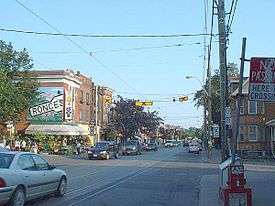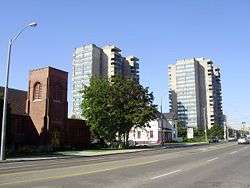List of neighbourhoods in Toronto

The strength and vitality of the many neighbourhoods that make up Toronto, Ontario, Canada has earned the city its unofficial nickname of "the city of neighbourhoods."[1] There are 140 neighbourhoods officially recognized by the City of Toronto[2] and upwards of 240 official and unofficial neighbourhoods within the city's boundaries.[3] Before 1998, Toronto was a much smaller municipality and formed part of Metropolitan Toronto. When the city amalgamated that year, Toronto grew to encompass the former municipalities of York, East York, North York, Etobicoke, and Scarborough. Each of these former municipalities still maintains, to a certain degree, its own distinct identity, and the names of these municipalities are still used by their residents, sometimes for disambiguation purposes. The area known as Toronto before the amalgamation is sometimes called the "old" City of Toronto, "Toronto proper", the Central District or simply "Downtown".
The "former" City of Toronto is, by far, the most populous and dense part of the city. It is also the business and administrative centre of the city. The uniquely Torontonian bay-and-gable housing style is common throughout the former city.
The "inner ring" suburbs of York and East York are older, predominantly middle-income areas, and ethnically diverse. Much of the housing stock in these areas consists of old pre-World War II single-family houses and post-war high-rises. Many of the neighbourhoods in these areas were built up as streetcar suburbs and contain many dense and mixed-use streets, some of which are one-way. They share many characteristics with sections of the "old" city, outside of the downtown core.
The "outer ring" suburbs of Etobicoke, Scarborough, and North York are much more suburban in nature (although these boroughs are developing urban centres of their own, such as North York Centre around Mel Lastman Square). The following is a list of the more notable neighbourhoods, divided by the neighbourhoods' location based on the former municipalities, the names of which are still known and commonly used by Torontonians.
Toronto has many groups and associations to deal with neighbourhood issues, and larger umbrella organizations organize events to deal with broader issues.
Neighbourhoods by district
Old Toronto

Old Toronto refers to the City of Toronto and its boundaries from 1967 to 1997. It is sometimes referred to as the "South" or "Central" district, and includes the "downtown core". Some of these names such as "The Fashion District" are (or were) used as marketing for the areas or by BIAs; this area is actually called "King-Spadina" by locals. Another example is the "Old Town of York", also known as "King and Parliament" (although that intersection is one block east of the original ten blocks that formed the old town).
Many were recreated or named to reconnect the areas with their past history, early beginnings, or even recent use and prominence. Some historical city 'wards' used in the 19th century are no longer used: St. David's, St. John's, St. Paul's, St. George's, St. Andrew's, and St. Patrick's wards. There was a ward named for the patron saint of each of the three British nationalities: English (St. George), Scottish (St. Andrew), Welsh (St. David) and the Irish Saint: (St. Patrick). St. George, St. Andrew and St. Patrick still survive as subway stops, though St. George station is not named after the ward, but after St. George Street, itself named after Quetton St. George, a local resident. St. Lawrence's Ward (named after the patron saint of Canada and the river) remains, known today as "St. Lawrence". St. Paul's (named after the saint) remains as the name of an electoral district for each of the three levels of government, although the electoral district has very little to no overlap with the historic St. Paul's Ward and beginning in the 2015 Canadian federal election, the electoral district was renamed Toronto—St. Paul's. This meant that the St. Paul's electoral district is a misnomer.
For the purposes of geographic distinction, the neighbourhoods of Old Toronto are broken down into four subsections:
East York
An autonomous urban borough until 1997, East York is located north of Danforth Avenue between the Don River and Victoria Park Avenue. East York was an exclave of York from 1922 to 1924. East York developed contemporaneously with the West End of old Toronto, and it is similar in form and character. In 1967, East York was expanded to include the Town of Leaside. Since the 1998 amalgamation, it is administered together with old Toronto, and separate from Scarborough, North York, and Etobicoke-York, by the "Toronto and East York Neighbourhood Council".
East York itself is commonly divided into two zones, with mainly Edwardian urban neighbourhoods situated south of Taylor-Massey Creek, and referred to as Old East York.
|
Old East York |
Suburban East York |
Bungalows in Old East York |
Etobicoke
Etobicoke is on the west side of the Humber River. Before the 1967 amalgamation, Long Branch, New Toronto, and Mimico were villages independent of Etobicoke. It was a separate city until the 1998 amalgamation. Since then, Etobicoke is often administered with York as a single community council within the amalgamated city of Toronto.
Etobicoke is often divided into three zones: north, central, and south, roughly approximate to that of the federal and provincial ridings.
|
Office towers at Islington-City Centre West |
Scarborough
Scarborough is on the east side of Victoria Park Avenue. It was a separate city until the 1998 amalgamation. West Rouge was transferred from Pickering to Scarborough in 1974 as part of the establishment of Durham Region. It was also the largest former municipality by area.
|
|
 Sheppard Avenue East in Agincourt |
North York
North York is located north of York, Old Toronto, and East York. It was a separate city until the 1998 amalgamation. North York is sometimes divided by two sections by Yonge Street.
|
 North York Centre in 2015 |
York
York is situated between Old Toronto and North York, west of Bathurst Street (aside from the neighbourhood of Tichester at the southeasternmost corner of the former city). Weston was independent of York until 1967. York was a separate city until the 1998 amalgamation. Since then, York is often administered with Etobicoke as a single community council within the amalgamated city of Toronto.
York is often divided to two sections: a western section and an eastern section; often, GO Transit's Barrie rail line divides the former city.
|
|
 Businesses and apartments along Weston Road in Weston |
History
Demographics
City-designated neighbourhoods
For administrative purposes, the City of Toronto divides the city into 140 neighbourhoods. These divisions are used for internal planning purposes. The boundaries and names often do not conform to the usage of the general population or designated business improvement areas. A number of neighbourhood maps of Toronto do exist, some produced by real estate firms and some by Internet portals. A project to map the neighbourhoods according to the common usage of the residents was done by the Toronto Star newspaper. Based on feedback from Star readers, it has produced a comprehensive, albeit informal, neighbourhood map.
Multiple listing service districts and neighbourhoods
After the update of Toronto Multiple listing service (MLS) on July 5, 2011, the Toronto Real Estate Board (TREB) introduced a new searching mechanism for the Toronto MLS, used by real estate agents operating in the region. MLS searches can be refined at three levels and MLS users can search houses by area, then by municipality, and then by neighbourhood or community. As with the other MLS services for other jurisdictions, it uses Microsoft's Bing Maps for its web mapping features. This was the first change of this magnitude in about 50 years of Toronto MLS history.[4]
The change was designed to eliminate the obsolete coding systems whereby Greater Toronto was divided into 86 artificial districts denominated by alphanumeric codes. Due to the growing population in the city and the increasing difficulty of browsing the code-based system, the TREB made a radical change, which is intended to simplify the use of MLS for real estate agents as well as home buyers.[5]
Because Toronto is a populous municipality of its own, the core city area will continue to be split into coded districts, although each of the districts will in turn contain neighbourhoods. Hence, the City will be easily searchable as well.[5]
The following table contains a complete list of Toronto districts with a possibly incomplete list of Toronto neighbourhoods within each district:[6][7]
Business improvement areas
There are also several dozen city designated business improvement areas, covering almost all of Toronto's commercial areas. Some of these serve a particular ethnic group or several similar ethnic groups as part of an ethnic enclave.
- Albion Islington Square
- The Beaches
- Bloor Annex
- Bloor by the Park
- Bloor West Village
- Bloor Yorkville
- Bloorcourt Village
- Bloordale Village
- Chinatown
- Church and Wellesley
- College Promenade
- College West
- Corso Italia
- Danforth Mosaic
- Danforth Village
- The Danforth
- Dovercourt Village
- Downtown Yonge
- Dundas Bathurst
- Dundas West
- Eglinton Hill
- Eglinton Way
- Emery Village
- Fairbank Village
- Forest Hill Village
- Gerrard India Bazaar
- Greektown on the Danforth
- Harbord Street
- Hillcrest Village
- Historic Queen Street
- The Junction
- Kennedy Road
- Kingsway
- Knob Hill Plaza
- Koreatown
- Lakeshore Village
- Liberty Village
- Little Italy
- Little Portugal
- Long Branch Village
- Mimico by the Lake
- Mimico Village
- Mirvish Village
- Mount Dennis
- Oakwood Village
- Old Cabbagetown
- Pape Village
- Parkdale Village
- Queen's Quay Harbourfront
- Regal Heights Village
- Riverside District
- Roncesvalles Village
- Rosedale Main Street
- Sheppard East Village
- St. Clair Gardens
- St. Lawrence Market Neighbourhood
- Toronto Entertainment District
- Upper Village
- Uptown Yonge
- Village of Islington
- West Queen West
- Weston Village
- Wexford Heights
- Wychwood Heights
- Yonge Lawrence Village
- York Eglinton
See also
References
- ↑ "The Globe's Insider's City Guides: Toronto" John Allemang, Tralee Pearce. The Globe and Mail. Jun 11, 2003. pg. T.1
- ↑ Toronto Neighbourhood Maps
- ↑ City of Toronto Residential Communities and Business Improvement Areas Map
- ↑ New Zoning in Toronto MLS Brings Neighbourhood Names and Municipalities by Jamie Sarner, accessed on July 5, 2011.
- 1 2 MLS Zoning Change: TREB Introducing Friendly Community Names by ILoveToronto.com, accessed on July 5, 2011.
- ↑ Looking at Homes: Your Daily Listings by Jamie Sarner, accessed on July 5, 2011.
- ↑ TREB Zones & Regions by Toronto Real Estate Board, accessed on July 5, 2011.
External links
- City of Toronto Neighbourhood Profiles
- Toronto Star Neighbourhood map
- Toronto Neighbourhood Guide
- Blog TO Neighbourhood map - focusing on restaurant and shopping districts
